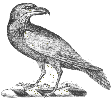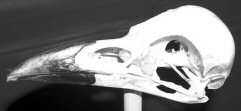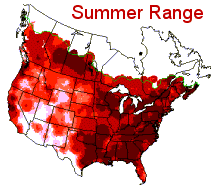 |
History
In English-speaking lands, the crow has always been called by that name. The common crow of England is called the carrion crow. The common eastern crow of the New World is popularly, but incorrectly known by the same name, although that name officially belongs to the American black vulture. Each Indian tribe had a name for the crow and because  of its non-secretive habits, it is one of the most familiar birds to the casual observer. The Sioux tell the story of how a white crow used to warn buffalo of approaching hunting parties. The buffalo would then stampede, and the hunters would be left hungry. Eventually, an angry Indian threw the bird in a fire which turned it black. of its non-secretive habits, it is one of the most familiar birds to the casual observer. The Sioux tell the story of how a white crow used to warn buffalo of approaching hunting parties. The buffalo would then stampede, and the hunters would be left hungry. Eventually, an angry Indian threw the bird in a fire which turned it black.
Early historical records reveal that "crow" has long been synonymous with "despicable predator". King Henry VIII put a public bounty on the crow along with its relation the rook. The crow also has a special distinction in the United States. During World War II, it was designated as an enemy of the American public and was subject to a widespread propaganda campaign that stated the "black bandits" were robbing the nation's farms of grain. Since most of the country's active hunters were in the armed forces, its doubtful that this campaign had a significant effect. In the early years of agriculture, conditions were ideal for supporting large crow populations, especially in the farm belt. Some places attracted roosts of great numbers with hundreds of thousands of crows. Shoots with many participants were often held, as well as dynamiting large numbers of crows in their winter roosts. In 1937, 26,000 birds were killed in one roost in Oklahoma. In 1940, 328,000 crows were killed in roosts in Illinois. Sometimes, trapping and poisoning were also used to limit crow numbers.
Originally, crows were simply classified as varmints and could be shot anytime of the year. However, the U.S. has negotiated a treaty with the Mexican government to protect several species that move back and forth between the two countries. The treaty covers the entire major bird family Corvidae, which includes crows, ravens and jays. So without it necessarily being intended, the crow is now a protected species with limitations on how they can be hunted. The sport season for crows can be for no more than 124 days and can't occur during the peak breeding period in each state.
More information on crow hunting regulations
More information on crow hunting history
General Description
 31 species of crows are found worldwide with exceptions being in New Zealand, South America and Antarctica. Scientific nomenclature places all birds in the CLASS: Aves. Their ORDER is Passeriformes which include the �songbirds� and �perching� birds. Their FAMILY is Corvidae which includes over a hundred species of Jays, Nutcrackers, Magpies, Jackdaws, Rooks, Choughs, Ravens and, of course, Crows. The GENUS is Corvus which includes all the ravens and crows. 31 species of crows are found worldwide with exceptions being in New Zealand, South America and Antarctica. Scientific nomenclature places all birds in the CLASS: Aves. Their ORDER is Passeriformes which include the �songbirds� and �perching� birds. Their FAMILY is Corvidae which includes over a hundred species of Jays, Nutcrackers, Magpies, Jackdaws, Rooks, Choughs, Ravens and, of course, Crows. The GENUS is Corvus which includes all the ravens and crows.
The American Ornithilogical Union (AOU) recognizes four species of crow in North America: The American or Common crow, Corvus brachyrhynchos, the Fish crow, Corvus ossifragus, the Northwestern crow, Corvus caurinus, and the Tamaulipas crow, Corvus imparatus, which was formerly named the Mexican crow. Some people and organizations sometimes recognize different races of the American crow, which is the most widespread.

Skull of the Common Crow
Crows, both male and female, have entirely black plumage, bills, legs, feet and claws. The body plumage and wings have a violet iridescence in strong light. Full albinism is rare with white wing feathers occurring more frequently. The body weight averages about a pound with a body length from 15�� to 21� and a wingspan up to 36�. Flight speed is about 30 mph with short bursts attaining 60 mph. Their eyesight is similar to that of a wild turkey, just make a move and see what happens. Their hearing is superb. All the species in this family are very bold and aggressive. In the wild, crows live 6 to 7 years. In captivity they reach 20 years with the oldest recorded at 30 years.
Voice
Their voice is not the melodic trill of most songbirds but variations of a coarse, loud "cawwww". Crows have an extensive repertoire and can communicate a surprising number of messages to fellow crows including alarm, feeding, rally, comeback and fight calls. They also have a series of courtship calls.
Habitat
Crows use a mixed habitat including woodlands for roosting, nesting and perching, open areas, agricultural fields, coastal wetlands, marshes, rivers and streams.
Breeding
Crows reach sexual maturity at two years of age but sometimes do not breed until later in their life. They are one of a few bird species that exhibit �cooperative breeding behavior� i.e. they will help to feed the incubating female, feed the nestlings and fledglings, defend the nest and keep watch over members of their family. They mate for life unless one is killed or incapacitated.
Nesting
Crows generally nest once per year. In the southern U.S. it is reported that sometimes they nest twice per year. Nest building usually commences in late March and takes about 5 days. They are usually placed moderately high (70� to 100�) in deciduous and coniferous trees. The nests are cup shaped and constructed of twigs and bark and lined with grass, leaves, hair, feathers etc. An average of 5 eggs are laid in late April to early May and hatch in about 20 days. The eggs are 1.6� and are bluish-green with brown markings. The young (average nest success is 3) remain in the nest for about a month and are fed even longer.
 Diet Diet
Being omnivorous, their diet consists of almost anything: seeds, fruits, nuts, insects, mollusks, earthworms, eggs, nestlings, frogs, mice, garbage and carrion. They are attracted to garbage dumps and have a well-known fondness for melons and corn. The habit of farmers placing scarecrows in their grain fields resulted from the crow�s incessant damaging and scavenging. Crows do help farmers however when they eat insects attracted by their crops.
Enemies
 Among the black bandits natural enemies are owls, primarily the great horned and some of the larger hawks (red-tailed, red-shouldered and goshawks). They exhibit a cooperative defense behavior where they will often gang-up on or �mob� an enemy until it leaves the area. Man is the number one enemy of the crow. Among the black bandits natural enemies are owls, primarily the great horned and some of the larger hawks (red-tailed, red-shouldered and goshawks). They exhibit a cooperative defense behavior where they will often gang-up on or �mob� an enemy until it leaves the area. Man is the number one enemy of the crow.
Habits
Crows are very social and live in family groups of between 2 to 15 birds, averaging 4 birds. A group of crows is called a �murder�. Pecking orders are evident as in all animals. Crows are territorial and are avid defenders of the same. They operate from central positions called roosts where they gather just before dark after returning from feeding on normal flight paths called flyways. Why they roost together is not, conclusively, known but it is thought for communal protection from predators. Winter roosts are communal and hold the largest numbers. When roosts are located in towns they cause many problems especially when there are thousands of birds. Towns have fought them with firecrackers, propane cannons, repellants and, sometimes, chain saws.
 The crow is probably the most intelligent bird on this continent and is well known for its ability to detect trouble. Crows quickly learn that a moving car is no danger, but will rapidly flee if the driver stops and gets out. In areas where they are constantly hunted, they learn the difference between a hunter with a gun and a farmer with farming implements. This degree of wariness is enhanced as the year progresses due to constant persecution by man. Crows use a system of guards that observe and sound warnings to all other crows in the area. These sentinels guard fields of feeding crows. They also send scouts in advance of feeding forays to check for danger. The crow is probably the most intelligent bird on this continent and is well known for its ability to detect trouble. Crows quickly learn that a moving car is no danger, but will rapidly flee if the driver stops and gets out. In areas where they are constantly hunted, they learn the difference between a hunter with a gun and a farmer with farming implements. This degree of wariness is enhanced as the year progresses due to constant persecution by man. Crows use a system of guards that observe and sound warnings to all other crows in the area. These sentinels guard fields of feeding crows. They also send scouts in advance of feeding forays to check for danger.
Migration
Crows are called "short distance migrants". Some may only move a few miles from the nesting territory to ones that move a few hundred miles. This seems to occur more in the northern climates where winters get fairly harsh.
American Crow
This species is the largest and most abundant of the crows found in North America. They are widely distributed from Canada to Mexico. Some claim there are sub-species or races of the American�Eastern, Western, Florida, etc.

American Crow Distribution Graphs
 Fish Crow Fish Crow
This species is slightly smaller than the American in body length (18� ) and weight (3/4 lb.). Identification can only safely be accomplished by voice comparison. Fish crows have a higher pitched, nasal call which is usually cut off on the end��caawwpp� instead of the familiar �caaawww�. Noted crow researcher, Dr. Kevin McGowan, likes to say that if you want to tell the species of a crow, ask it if it is an American crow. Fish crows will deny it by saying, nasily �uh-uh�.
Originally they were found along the southeastern coastline but their range has expanded dramatically into the states of Arkansas, Tennessee, Kentucky, Mississippi, Oklahoma, Illinois and Kansas. Populations are on the increase.
Fish Crow Distribution Graphs
Northwestern Crow
This species is smaller than the American but larger than the fish crow. They are a beach-combing crow found along the coastal tidelands of Alaska south to Washington and Oregon states. Their voice is said to be more resonant than the American. Their diet consists of more aquatic invertebrates than the other species. The Audubon Field Guide reports that this species preys heavily on unattended eggs and hatchlings in cormorant and gull colonies.
Northwestern Crow Distribution Graphs
 Tamaulipas Crow (Mexican) Tamaulipas Crow (Mexican)
This species is a 15� crow with a soft, croaking voice issuing a �gar-lic� sound. They, typically, live in the arid, open country of Northwest Mexico and South Texas. Quite a population is reported near Brownsville, Texas. They nest low in shrubs and native tree species like the mesquite. |
 |













 of its non-secretive habits, it is one of the most familiar birds to the casual observer. The Sioux tell the story of how a white crow used to warn buffalo of approaching hunting parties. The buffalo would then stampede, and the hunters would be left hungry. Eventually, an angry Indian threw the bird in a fire which turned it black.
of its non-secretive habits, it is one of the most familiar birds to the casual observer. The Sioux tell the story of how a white crow used to warn buffalo of approaching hunting parties. The buffalo would then stampede, and the hunters would be left hungry. Eventually, an angry Indian threw the bird in a fire which turned it black. 31 species of crows are found worldwide with exceptions being in New Zealand, South America and Antarctica. Scientific nomenclature places all birds in the CLASS: Aves. Their ORDER is Passeriformes which include the �songbirds� and �perching� birds. Their FAMILY is Corvidae which includes over a hundred species of Jays, Nutcrackers, Magpies, Jackdaws, Rooks, Choughs, Ravens and, of course, Crows. The GENUS is Corvus which includes all the ravens and crows.
31 species of crows are found worldwide with exceptions being in New Zealand, South America and Antarctica. Scientific nomenclature places all birds in the CLASS: Aves. Their ORDER is Passeriformes which include the �songbirds� and �perching� birds. Their FAMILY is Corvidae which includes over a hundred species of Jays, Nutcrackers, Magpies, Jackdaws, Rooks, Choughs, Ravens and, of course, Crows. The GENUS is Corvus which includes all the ravens and crows.
 Diet
Diet
 The crow is probably the most intelligent bird on this continent and is well known for its ability to detect trouble. Crows quickly learn that a moving car is no danger, but will rapidly flee if the driver stops and gets out. In areas where they are constantly hunted, they learn the difference between a hunter with a gun and a farmer with farming implements. This degree of wariness is enhanced as the year progresses due to constant persecution by man. Crows use a system of guards that observe and sound warnings to all other crows in the area. These sentinels guard fields of feeding crows. They also send scouts in advance of feeding forays to check for danger.
The crow is probably the most intelligent bird on this continent and is well known for its ability to detect trouble. Crows quickly learn that a moving car is no danger, but will rapidly flee if the driver stops and gets out. In areas where they are constantly hunted, they learn the difference between a hunter with a gun and a farmer with farming implements. This degree of wariness is enhanced as the year progresses due to constant persecution by man. Crows use a system of guards that observe and sound warnings to all other crows in the area. These sentinels guard fields of feeding crows. They also send scouts in advance of feeding forays to check for danger. 
 Fish Crow
Fish Crow Tamaulipas Crow (Mexican)
Tamaulipas Crow (Mexican)